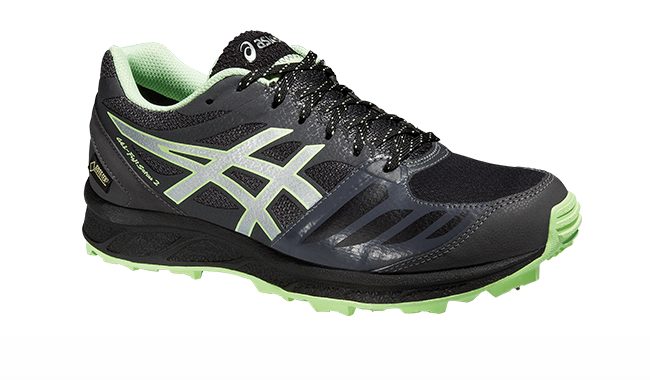Gear review: 2016 winter running shoes

Canadians see a variety of crazy cold weather conditions. From that lonely, frozen highway to a foot of fluffy snow to the hidden black ice on a city street, in this country we need all sorts of options to keep running through the new year. Triathletes don’t need to fear the cold and stick to the dreadmill this winter. Try one of these great models for some serious winter running in 2016.
Editor’s Pick
Asics GEL-Fujisetsu 2 G-TX
$190, Men’s 337 g (11.9 oz.); Women’s 283 g (10 oz), Drop ratio: 10 mm
The Fujisetsu’s low-to-the-ground design provides a super responsive feel and fantastic control in sketchy conditions. Fittingly,“Setsu” is the Japanese word for snow, and the sharp spikes underfoot can handle a whole lot more than just the white fluffy stuff. Just about the only thing the Fujisetsu 2 wasn’t able to chew up was asphalt, which will always be an issue with spiked shoes. Those looking for a more aggressive shoe will like the fit and feel of the Fujisetsu 2. It’s a firm ride with an impenetrable Gore-Tex upper for the worst conditions.
 Brooks Adrenaline ASR 12 GTX
Brooks Adrenaline ASR 12 GTX
$180, Men’s 335 g (11.8 oz.); Women’s 281 g (9.9 oz), Drop ratio: 12 mm
Brooks took one of the most popular trainers of all-time, wrapped it in Gore-Tex and decked it out with a monster of an outsole tread. The Adrenaline became such a big hit over a decade ago because of its soft, comfy fit and sturdiness. Adding a breathable, waterproof membrane to the plush, padded upper keeps out slush and snow without suffocating your feet. The trail-oriented toothy outsole blasts through gnarly conditions and does a decent job of grabbing onto black ice so that you don’t take a nasty fall during a winter run. Fans of the Adrenaline will love this cold weather option. It would also make for a decent, although heavier, shoe for spring and fall trail races.
 Merrell All Out Terra Ice
Merrell All Out Terra Ice
$180, Weight (unisex): 365 g (12.8 oz.), Drop ratio: 6 mm
As a strong outdoor brand that makes excellent hiking and trail-running footwear, Merrell is well suited to produce a strong winter specific shoe. The Vibram outsole performed best in icy conditions of any shoe we’ve ever tested. That’s primarily due to the nine tungsten spikes positioned at the key contact points on the foot. The spikes aren’t noticeable when on soft surfaces, but aren’t ideal for those transitioning from a dry road. The waterproof upper has a minimal, sleek design and that signature Merrell fit, which will appeal to runners who like a roomy and flexible forefoot.
 Skechers RunGo Ultra 2
Skechers RunGo Ultra 2
$120, Men’s 238 g (9.3 oz.); Women’s 207 g (7.3 oz.), Drop ratio: 4 mm
This update of Skecher’s entry into the maximalist category is a soft ride. The ample eva foam midsole is about as cushy as it gets. Version two sees the addition of a heel counter, which is a great idea, as the first version of the Ultra was so soft and flexible it felt sloppy at times. Skechers reduced the number of overlays on the upper, yet there’s enough protection from the elements to keep our tester’s feet remarkably dry, even during a rainy run. Fans of a marshmallowy, light shoe will like the Ultra 2.
 Zoot Solana ACR
Zoot Solana ACR
$120, Men’s 235 g (9.0 oz.); Women’s 255 g (8.3 oz.), Drop ratio: 8 mm
For a company founded in Hawaii and headquartered in southern California, Zoot have made a solid winter option in the Solana ACR. This weatherproofed version of their neutral trainer is soft and flexible, with an added weather-resistant upper and a touch of rubber underfoot for improved grip. The Solana ACR will be best suited for those who mainly run in the city in winter, as it lacks heavy lugging. But the upper does the trick, even in heavy rain, and is a desirable weight and fit for many neutral runners.
 Pearl Izumi Trail N2 V2
Pearl Izumi Trail N2 V2
$155, Men’s: 283 g (10.5 oz.); Women’s 255 g (9 oz.), Drop ratio: 8 mm
Not strictly a winter-specific model, the Trail N2 is a solid option for urban runners looking to pick up a functional bad weather option. The N2 is one of our favourite neutral trail shoes. Its outsole is the reason why we recommend it for battling the elements in the city in winter. The multi-directional lugs provide great traction but don’t feel cumbersome when hitting a dry patch of pavement. The wide toe box allows for a thicker winter sock. The upper isn’t waterproofed, but it provides enough protection for most conditions, as it was designed to trudge through mucky trail situations.
 Saucony Xodus 6.0 GTX
Saucony Xodus 6.0 GTX
$165, Men’s: 352 g (12.4 oz.) Women’s: 301 g (10.6 oz.), Drop ratio: 8 mm
Saucony describes their Xodus as “the atv of running shoes.” It’s an apt comparison, as this beast can work through the thickest mud or slipperiest snow. Underfoot, the blown-out Vibram lug tread is nicely arranged so that snow or debris won’t get wedged in. The upper of the Xodus is equally as serious. Gore-Tex is employed for fast-drying waterproofing. The fit is similar to that of Saucony’s slighter trail shoe the Peregrine. The Xodus is bulky at 12.4 oz., but if you’re running in very poor conditions this sixth iteration is a solid choice.
New Balance 910 v2
$140, Men’s 306 g (10.8 oz.); Women’s 251 g (8.9 oz.), Drop ratio: 8 mm
We liked the durability and grit of the first version of the 910, and this update sees New Balance wisely improve upon the shoe’s flexibility. Instead of switching to their new, softer and lighter Fresh Foam, the American running shoe specialists stick with their Revlite midsole, which our testers found to be a wise idea, as it’s a firmer ride, which fits well with the overall tactile approach of the 910. The outsole is pocked with a plethora of grippy nodules and a Rockstop plate at the ball of the foot. Our favourite aspect of this update, however, was in its overall aesthetic. New Balance is making really pretty shoes, and this is sure to be a standout on the trail or cutting through the the snow.



